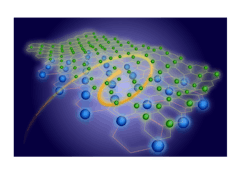HRL Laboratories aims at developing nanoelectronic materials for quantum computing and signal processing
ARLINGTON, Va. – U.S. military researchers needed enabling technologies for quantum nanoelectronic devices with enhanced performance and improved size, weight, and power (SWaP). They found a solution from HRL Laboratories LLC in Malibu, Calif.
Officials of the U.S. Defense Advanced Research Projects Agency (DARPA) in Arlington, Va., announced a $7.1 million contract to HRL Laboratories last week for the Synthetic Quantum Nanostructures (SynQuaNon) program.
HRL Laboratories and possibly other yet-to-be-named contractors will develop enabling technologies in synthetic quantum materials for quantum computing, and develop enhanced superconducting nanoelectronic devices based on electronic composite materials.
Potential devices that could benefit from these kinds of materials include superconducting qubits that operate at elevated temperatures and frequencies; photon detectors and bolometers with high sensitivity and timing resolution for sensing, imaging, and communications; and quantum-limited signal processing technologies for scalable computing, millimeter-wave communications, and quantum-enhanced sensing.
Related: The future of artificial intelligence and quantum computing
Applications could include sensing of weak magnetic fields; photon detection across wide swaths of the electromagnetic spectrum; low-noise signal processing; and efficient, high-speed classical and quantum computation.
HRL will develop and benchmark routes to enhanced superconducting nanoelectronic devices based on artificially structured electronic metamaterials.
Although there have been limited technological advances in superconducting technologies, widespread adoption has been limited by the need for cryogenic cooling -- often to temperatures below 1 Kelvin, DARPA researchers explain.
HRL experts will seek to demonstrate not only new ways to make synthetic electronic materials for quantum information processing, but also validate and benchmark their proposed materials with proof-of-concept quantum circuits or nanoelectronic device architectures that incorporate proposed materials.
The SynQuaNon program will fabricate proof-of-concept quantum nanoelectronic devices as test beds for materials characterization, and assess the compatibility of such materials within device architectures.
The goal is to provide a better understanding of promising materials for superconductor-based quantum technologies, and to determine the viability these materials to harness, tune, or enhance quantum effects in quantum devices.
HRL will focus on synthetic composite that include nanopatterned electronic structures, Moiré materials, and quantum heterostructures. Company experts will work to ensure that proposed composite materials and devices are compatible with scalable fabrication techniques.
SynQuaNon has a two-year first phase to demonstrate electronic composite materials. A two-year second phase will move to device-scale tunability and performance enhancements.
For more information contact HRL Laboratories online at www.hrl.com, or DARPA at www.darpa.mil.
About the Author
John Keller
Editor-in-Chief
John Keller is the Editor-in-Chief, Military & Aerospace Electronics Magazine--provides extensive coverage and analysis of enabling electronics and optoelectronic technologies in military, space and commercial aviation applications. John has been a member of the Military & Aerospace Electronics staff since 1989 and chief editor since 1995.
